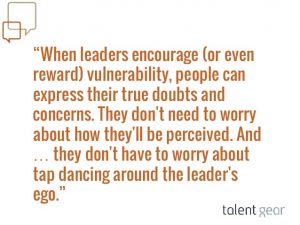Why The Best Leaders View Vulnerability as a Strength
By Ray Williams, April 20, 2019

There is compelling evidence that leaders who are prepared to show their vulnerability more easily gain the trust of others, and are, in fact, more effective leaders.
Admitting our mistakes, seeking help, apologizing, and acknowledging we don’t have the answers all involve expressions of vulnerability.
Defining Vulnerability
Dictionary definitions of vulnerability focus on weakness: “defenselessness, powerless, passivity, feebleness.” Yet the synonyms of “openness, receptivity and sensitivity” are rarely referenced.
Psychologist Robert D. Stolorow says “It is pervasive in our cultural meaning-making to equate vulnerability–whether physical, emotional, or existential–with something shameful, an abhorrent weakness to be kept hidden and evaded, or counteracted through some form of reactive aggression and destructiveness. Vulnerability, in other words, is regarded as an aberration, a contemptible anomaly to be expunged from our experiential world.”Poet David Whyte says: “Vulnerability is not a weakness, a passing indisposition, or something we can arrange to do without, vulnerability is not a choice , vulnerability is the underlying, ever present and abiding under-current of our natural state.”
According to author Brené Brown, Ph.D, LMSW, in her latest book Daring Greatly: How the Courage to Be Vulnerable Transforms the Way We Live, Love, Parent and Lead, “Vulnerability is the core, the heart, the center, of meaningful human experiences.” She defines vulnerability as “uncertainty, risk and emotional exposure.”

Myths and Misconceptions About Vulnerability

Brené Brown describes three myths about vulnerability:
- Vulnerability is a weakness. Brown says “To feel is to be vulnerable.” So when we consider vulnerability to be a weakness, we consider feeling one’s emotions to be so, too, she says, “Vulnerability sounds like truth and feels like courage.”
- Some people don’t or can’t experience vulnerability.Virtually Everyone feels vulnerability at one point in their life. “Life is vulnerable,” Brown writes. Being vulnerable isn’t the choice we have to make, she says. Rather, the choice is how we respond when the elements of vulnerability greet us: uncertainty, risk and emotional exposure. Many of us respond by avoiding or suppressing vulnerability.
- Vulnerability means spilling some of your secrets. Some of us hesitate to be vulnerable because we assume that means exposing our “secrets.” We assume that being vulnerable means spilling our hearts to strangers, and as Brown puts it, “letting it all hang out.” But vulnerability embraces boundaries and trust, she says. “Vulnerability is about sharing our feelings and our experiences with people who have earned the right to hear them. Being vulnerable takes courage.”
Another Myth: You Can Go It Alone.None of us, in recognizing our vulnerability, should pretend we are able to “go it alone.” When we ask others “Can you help me with this? What are your thoughts on this issue? Are you willing to work on this together with me?” we are expressing our vulnerabilities in a courageous and positive way.
Research
According to a team of psychologists writing in the Journal of Personality and Social Psychology contrary to our worst fears, having the courage to show our vulnerability in these ways will often be rewarded. That’s because there is an intriguing mismatch in the way we take a more negative view of our own vulnerability than we do of other people’s – the researchers call this “the beautiful mess effect”.
Anna Bruk and her colleagues at the University of Mannheim conducted seven studies with hundreds of participants. The format for many was that the participants were asked to imagine scenarios in which either they or another person displayed intentional vulnerability – such as confessing romantic love or admitting to a mistake – and then they either rated their own vulnerability (e.g. how strongly they agreed they had shown courage or weakness), or the other person’s vulnerability, respectively. Time and again, and across many different contexts, participants perceived their own vulnerability more negatively and less positively than other people’s.
Bruk and her team found evidence that when we think about our own vulnerability we do so very concretely whereas when we think about others’ vulnerability we do so more abstractly. The researchers argue their findings are important given earlier research showing the benefits of expressing vulnerability: self-disclosure can build trust, seeking help can boost learning, admitting mistakes can foster forgiveness, and confessing one’s romantic feelings can lead to new relationships.
“Even when examples of showing vulnerability might sometimes feel more like weakness from the inside, our findings indicate, that, to others, these acts might look more like courage from the outside,” Bruk and her colleagues concluded. “Given the discussed positive consequences of showing vulnerability for the relationship quality, health, or job performance, it might, indeed, be beneficial to try to overcome one’s fears and to choose to see the beauty in the mess of vulnerable situations.”
In the January-February 2017 print edition of the Harvard Business Review,neuroeconomist Paul J. Zak puts forth his team’s decades-long research into how humans build trust. The article, “The Neuroscience of Trust,” Zak explains that “when an individual asks for help, the oxytocin levels of the person receiving the request increases. (Oxytocin is a brain chemical that is associated with, among other things, social bonding.) In other words, when a person demonstrates vulnerability, others are socially inclined to assist.” Far from being a sign of leadership weakness, expressing uncertainty or requesting assistance (in moderate doses) builds camaraderie. “Asking for help is the sign of a secure leader– one who engages everyone to reach goals,” writes Zak.
Vulnerable Leaders
In today’s business world, employees, shareholders and customers alike demand honest and transparent CEOs—those who are not only confident, but can be trusted. Yet recent Edelman Trust Barometers show that trust in business leaders is declining. Compounding this disturbing trend, the prevalence of corporate misconduct, value destruction, and toxic corporate cultures, executives may earn as much as 271 times more than the average worker.
To shake the image of the self-serving CEO with little to lose, business leaders need to be honest about their vulnerabilities – their own, their partners’, and their business’ susceptibility to loss or mistakes. If CEOs continue to act as though they have nothing to lose, or act out of self interest they will fail to regain trust.

In business, vulnerability has been generally seen as weakness. Media headlines encourage businesses to avoid vulnerability or suffer the consequences: “30% of Auto Parts Retailers’ Business Is Vulnerable to Amazon,” “Five Industries Most Vulnerable to Digital Disruption,” “Apple Users Are Also Vulnerable to WannaCry-Type Attacks.” Personal vulnerability is considered a liability for leaders and their organizations, so it is studiously avoided. Conventional wisdom holds that it is difficult to lead or negotiate or make demands from a position of perceived weakness.
Not all leaders believe this. Howard Shultz, CEO of Starbucks, once said, “The hardest thing about being a leader is demonstrating or showing vulnerability… When the leader demonstrates vulnerability and sensibility and brings people together, the team wins.”
Great leaders recognize the importance of bringing vulnerability to work because it is the foundation for open and nonjudgmental communications. Vulnerability fuels the strongest relationships, and ultimately, helps bring even more success to your organization.
What Vulnerable Leaders Do
Being vulnerable in the workspace doesn’t mean you walk around with a box of tissues and share your deepest, most personal secrets with everyone. So what does being vulnerable in the work environment look like? The Power of Vulnerability: How to Create a Team of Leaders by Shifting INward authors Barry Kaplan and Jeffrey Manchester describe some of the behaviors of vulnerable leaders:
- They accept vulnerability as a strength. Being vulnerable isn’t a bad thing and it doesn’t make you weak; it actually makes you a better leader because you stop wasting energy protecting yourself from what you think other people shouldn’t see. It allows you to start showing your authentic self. By accepting vulnerability as a strength, you stop worrying about having every answer and realize it’s okay to be wrong.
- They admit and own their mistakes.We all make mistakes, especially as leaders. The more willing we are to admit and own our mistakes (not make excuses, point fingers, or avoid responsibility) the more others will trust us and want to follow our lead. Taking responsibility, apologizing, and making amends for the mistakes we make are not always easy things to do, but they’re essential for us to have true credibility with the people around us.
- They share their fears and insecurities.Fear and insecurity are inseparable from being human and being a leader. We all get scared, but too often deny or avoid it, so as not to look weak. However, admitting our fear and sharing it with others does a few important things. First of all, it can free us up from the fear itself. Second of all, it allows others to realize we’re human. Third, it gives the people around us permission to feel and express their own fear, which is essential for individuals and groups if they’re going to come together and move through adversity. Sharing our fears with others is not something we do to make excuses or to dump our “stuff” onto other people, it’s a bold act of vulnerable leadership and something that can have a profound impact on those around us.
- They don’t take themselves too seriously. t’s important for us to have a sense of humor and not get too full of ourselves, which is something many of us do, particularly as a leader. As I jokingly say to my wife Michelle sometimes, “Do you have any idea how important I think I am?” We must laugh at ourselves, notice when we get too serious, and have enough self awareness to keep things in a healthy perspective.
- They share their own process, journey, and challenges. We’re always going through a process of growth, discovery, and challenge in life — especially as leaders. This process doesn’t have to be difficult or painful, although sometimes it can be. The more transparent we are about our own process and the more willing we are to let the people around us know what we’re dealing with, learning, and challenged by, the more we let them know who we truly are, give them insight into how we operate, and create an environment around us that is open, authentic, and conducive for individual and collective growth.
- They ask for and receive help from others.As leaders. most of us like to help others, but often we have a difficult time asking for and receiving help. Requesting help can be perceived, especially by us, as an admission of weakness or an acknowledgment that we’re not capable of doing something. However, all of us need help and support — and in some cases, we need a lot of it. Being the kind of leader who is comfortable enough with yourself and the people around you to admit when you don’t know something, can’t do something, or simply need help in making something happen, is not a sign of weakness; it’s both a sign of strength and an opportunity to empower others in an authentic way.
- They continually check their ego at the door. Most CEOs’ Achilles heel is their hubris. Checking your ego is the first introspective step towards managing our humanness in the executive suite. In our experience, most CEOs operate in a kind of echo chamber in which the executive team panders to them (several studies have documented this). Invariably, this results in leaders overestimating their performance and capabilities relative to competitors, leading to inflated projections and value destruction. A useful guideline for how to diagnose and disable hubris can be found here.
- They open up to address relational vulnerability. Vulnerability involves allowing someone to act in your interests when you are looking the other way. Authentic CEOs get into trouble when they extend trust without expressly acknowledging it. Instead, any act of trust must involve a clear and judicious identification of the vulnerability and the threats involved
- They stop the spin in tackling “exogenous vulnerability.” Setbacks will happen. Public relations-inspired rhetoric are often superficial (eg: the BP disaster); it follows the playbook of accepting mistakes, apologizing, and outlining proposed changes. In an era of fake news and information overload, authenticity is only present in the simple truth.
Highly regarded leaders are not shy about their vulnerabilities. The head of Berkshire Hathaway, Warren Buffett, Apple chief executive Tim Cook, and the chair and CEO of JPMorgan Chase, Jamie Dimon, spring to mind. Buffett, for instance, repeatedly tells us that Berkshire’s returns are unsustainable and that every day he allays his fears by building partnerships with the CEOs of the businesses owned by his company. Dimon is a strong proponent of the importance of admitting what you do not know. Cook, meanwhile, has often taken personal responsibility for Apple’s product failures and hiring blunders, as well as his personal weak spots.
Patrick Lencioni, author of The Five Dysfunctions of a Team,” is a strong proponent of leaders who show vulnerability. Lencioni writes that “the strongest people in life are the ones that are comfortable saying ‘I don’t know.’” To Lencioni, vulnerability is not at all soft — “it’s the key to building great teams.”
The Positive Benefits of Vulnerable Leaders
In fact, there are plenty of reasons to believe that vulnerability can be an asset for leaders, as Emma Seppala argued in this 2014 Harvard Business Review article. Why? Vulnerable leaders inspire, are more authentic, and build bonds that lead to increased performance.
Seppala goes on to describe the outcome benefits and characteristics of vulnerable leaders, most notable of which are:
- “Vulnerability allows for building greater bonds and increasing emotional connection. Earlier this year, I noted teams that bond together through shared experiences often perform better. Vulnerability plays a key role in laying the groundwork for such experiences. When leaders are vulnerable, they are more open and emotionally available, which creates more bonding opportunities and improves team performance.”
- “Vulnerability is required for authenticity.We know that authenticity helps build trust, which is especially valuable now, when trust in business and leaders in general is sorely lacking. And authenticity means being open and honest about your beliefs and values. Authentic behaviors include admitting mistakes, showing emotion, and not hiding behind a manufactured facade. It’s impossible to be authentic without being willing to be vulnerable…Research shows that onlookers subconsciously register lack of authenticity. Just by looking at someone, we download large amounts of information to others… ‘We are programmed to observe each other’s states so we can more appropriately interact, empathize, or assert our boundaries, whatever the situation may require,’ says Paula Niedenthal, Professor of Psychology at the University of Wisconsin-Madison. We are wired to read each others’ expressions in a very nuanced way. This process is called “resonance” and it is so automatic and rapid that it often happens below our awareness.”
- “Vulnerability inspires teams.In 2011, professors Peter Fuda and Richard Bahdman, of Australia’s Macquarie Graduate School of Management, conducted an in-depth study of seven CEOs that had experienced remarkable personal growth and professional success in their businesses. Vulnerability emerged as a key theme from their interviews and linguistic analysis.”
- “Vulnerability allows for building greater bonds and increasing emotional connection.Earlier this year, I noted teams that bond together through shared experiences often perform better. Vulnerability plays a key role in laying the groundwork for such experiences. When leaders are vulnerable, they are more open and emotionally available, which creates more bonding opportunities and improves team performance.”
Other Benefits of Leader Vulnerability
- It decreases tension and stress at work. Have you ever worked somewhere with an elephant in the room, and nobody was talking about it? Avoiding and tiptoeing around secrets at work can be very stressful. Everyone’s blood pressure rises trying to figure out ways of avoiding uncomfortable topics when they come up. Stress could be decreased considerably by acknowledging uncomfortable topics and allowing people to talk about them. If everyone sees that their leaders are able to bring up unpopular areas for discussion, they will feel freer and less stressed to talk about them as well.
- It increases flow of ideas, creativity, and innovation. By acknowledging that they don’t have all the answers, leaders give freedom for all staff to have input and have their feedback and ideas considered. By admitting their mistakes, managers give their staff more room to contribute their feedback and ideas to the organization. Leaders who acknowledge they made poor decisions and are still able forgive themselves, through their example, let those under them know that it is okay to take risks and try something new and untried. This leads to more ideas coming forth at all levels, creating a more dynamic, competitive organization
- Emotional connections leads to less turnover. A great deal of workplace research points out that being emotionally connected to a workplace is often a deciding factor on whether or not people will stay or look elsewhere. An open, honest and authentic leadership makes it much more likely that staff at all levels will feel a connection to the organization at an emotional level when they feel connected with their leaders. They are less likely to jump ship, even for more money or benefits, when they feel their leaders have their best interests at heart.
A leader who shows vulnerability is someone who stops feeling compelled to be the first one with an idea or the first one to answer a question. Becoming vulnerable requires a mindset shift where you start to see the aspirations of the business through the eyes of the people you lead. This invites them to become more involved in – and in fact to become the drivers of – the conversation. When you are vulnerable, your employees feel more connected, invested, respected, and vital to the organization. Everyone benefits.
Now more than ever, the world needs leaders who are vulnerable, empathetic, and compassionate—servant leaders—who put the interests of others and the world first. We’ve seen how the other kinds of leaders—self-serving, narcissistic (and sometimes psychopathic) and toxic—have created chaos and damage. It’s time for a change.
Copyright: Neither this article or a portion thereof may be reproduced in any print or media format without the express permission of the author.
Read my latest book:
I Know Myself And Neither Do You: Why Charisma, Confidence and Pedigree Won’t Take You Where You Want To Go, available in paperback and ebook formats on Amazon and Barnes and Noble world-wide.


